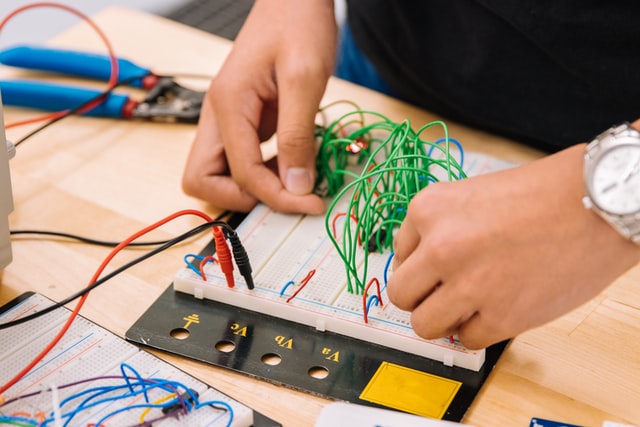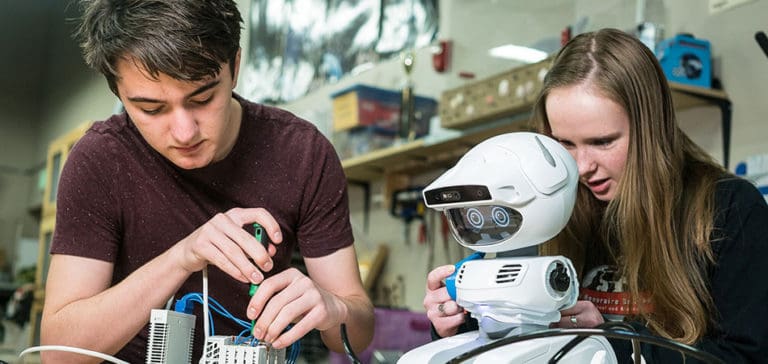We have a STEM problem in the United States. Once a world leader, the United States currently ranks 27th among developed nations in the number of bachelor’s degrees given in science or engineering. What’s more alarming is that the same research indicates that only around 30 percent of Americans believe that our education system has the capacity to provide young people with the minimum requirements to fill these STEM jobs.
 Photo by Jeswin Thomas on Unsplash
Photo by Jeswin Thomas on Unsplash
We contend that these findings are only symptoms of a larger problem with STEM: The current approach to STEM education is far too exclusionary and siloed—a problem that has been exacerbated by the Covid-19 crisis.
For far too long, STEM educators have responded to statistics such as these by suggesting we ramp up more of the same approach we’ve been trying for years—more rigor, more drill and kill, and more abstract, one-size-fits-all approaches that leave too many students on the sidelines, welcoming only those who fit a certain mold. If you don’t love factoring quadratics, if you haven’t learned Python by the age of 10, or if you have never won a prize in a school science fair, sorry, you don’t make the cut.
We have to be honest with ourselves: The way we have implemented STEM has been far too narrow and has made proficiency with technology a prerequisite for success. While it may not have been obvious to us, this approach is exclusionary to a lot of kids. The time is ripe for an overhaul of STEM curriculum to reset our sights on developing problem-solving skills and creativity.
NEW APPROACHES TO STEM
The good news is that there are countless educators who are making a commitment to a more engaging approach by adopting context over content and restoring joy and wonder to STEM. This, in our view, is the way that true STEM teaching and learning should happen—and, not surprisingly, it starts by building a strong relationship with every student. This investment to establish trust enables the teachers to craft problems, projects, and challenges relative to issues that students care about, rather than expecting that they must always come to us, to our problem, to our topic.
This empathy-driven process, whereby students become co-designers of their learning, is but one of several characteristics we have found to define a more powerful STEM teaching and learning experience. The following examples highlight other characteristics that can help STEM educators make this important shift, even in the time of Covid.
-
Students at the Northeast Academy for Aerospace and Advanced Technologies were given the chance to learn collaboration and project management skills while remotely coding and flying drones. Skype a Scientist is a free program that connects students directly with researchers in the field through livestreams that anyone can join. In both of these cases, educators are able to use technology to enhance the learning experience while holding students to high expectations. This allows not only deeper learning, but also the ability for teachers to provide targeted support for each student’s path of academic growth.
-
Teachers have ample opportunity to provide their students with more cross-curricular connections to problem-solving through citizen-science initiatives where students take part in real scientific studies from the comfort of their own home. iNaturalist is a free resource that allows individuals to upload photos of wildlife or local habitats from a phone to a database that scientists use to monitor the health and biodiversity of ecosystems around the world. Also, math teacher Chris Anderson has created dailySTEM.com, a platform that provides educators and families with dozens of simple STEM resources that connect students with real-world learning.
-
The teachers and staff at William R. Davie Middle S.T.E.M. Academy realized that a technology-rich approach was not feasible in a district with a significant number of students who didn’t have reliable internet access. Rather than resort to uninspiring packets of worksheets, they developed a “STEM in a Bag” opportunity that provides students with basic materials to use design thinking to solve real challenges. These customized kits are delivered to students and allow them the creative freedom to design and test prototypes and then share what they learn. Such a less-is-more approach recognizes that real-world answers rarely fit nicely at the end of the book!
-
Classroom blogs are another great way to foster meaningful conversation, whether face-to-face or virtually. The rules of engagement are crucial, but these blogs can build a culture of rich, authentic discussion that helps students hone their writing skills and transfer knowledge across disciplines. Australian primary teacher Kathleen Morris has used this approach for years to help students deepen their digital-literacy knowledge and learn how to collaborate across networks.
-
Science Around Cincy is a web-based show featuring scientists, researchers, and engineers in the Cincinnati region. The series, which Chris Woods hosts and for which he serves as an executive producer, exposes students to different STEM careers and pathways while teaching key science concepts. Each episode comes with discussion guides and activities that can seamlessly integrate with remote learning and middle-school curriculum.
You may have noticed that the characteristics emphasized in these examples could work equally well in non-STEM areas. That’s the point—the world doesn’t solve problems in silos, and neither should our students. Real, interdisciplinary learning in STEM or otherwise must be at the core of everything we do, with appropriate and targeted support that’s provided just in time rather than just in case.
This approach to STEM teaching is not easy. Having students do the same problem set and the same lab, having them listen to the same lecture, and giving them the same multiple-choice test is certainly an easier approach. But teaching in a truly personalized, learner-centered manner is infinitely more rewarding.
We suggest that by creating such an environment, you will be one of those who are truly solving our country’s problem with STEM. You will be one of the leaders who are transforming STEM from its traditional definition into one that is more welcoming, inclusive, and approachable for all students. That’s the kind of authentic STEM teacher we should all aspire to be. You in?
Discover more STEM Resources with RobotLAB!



